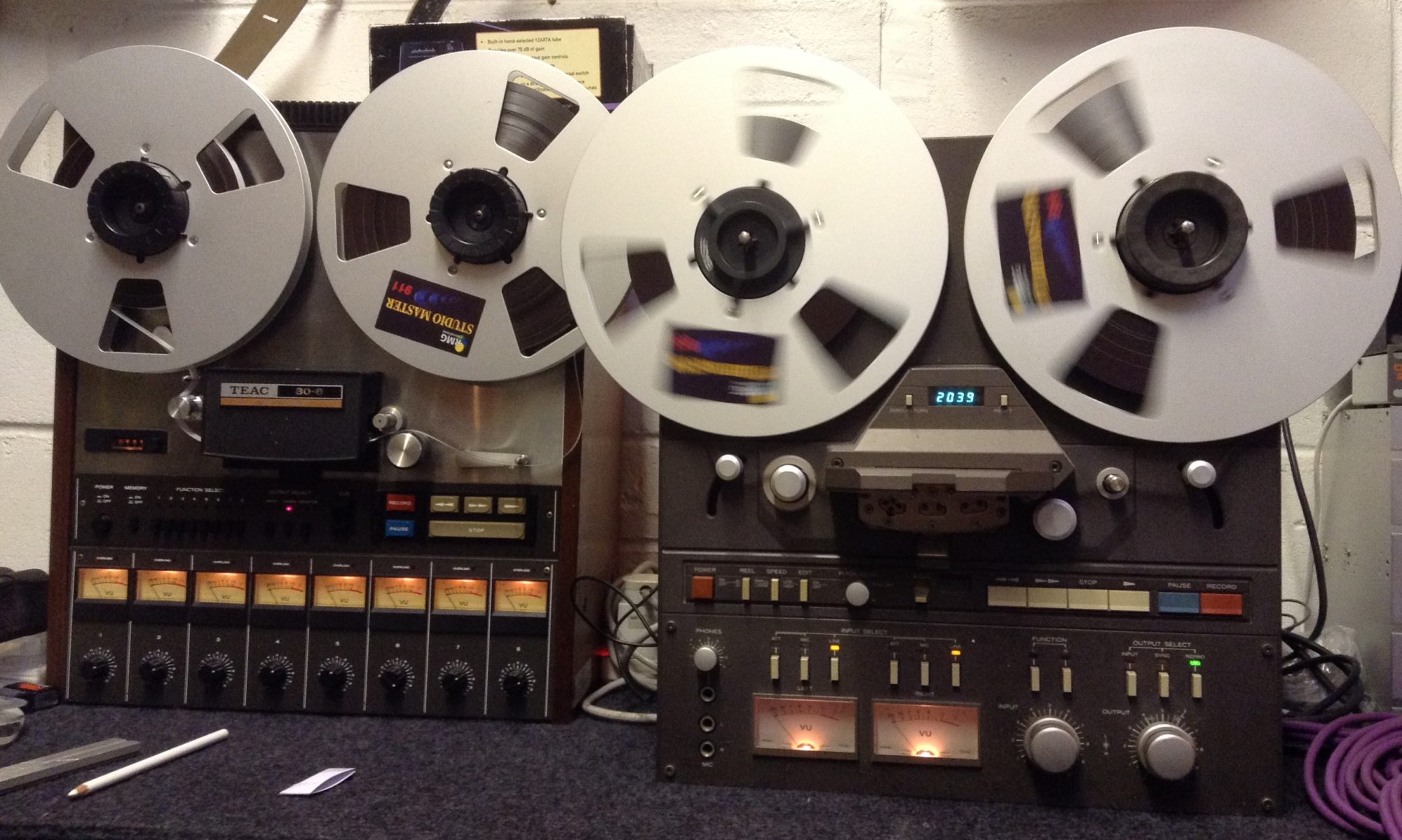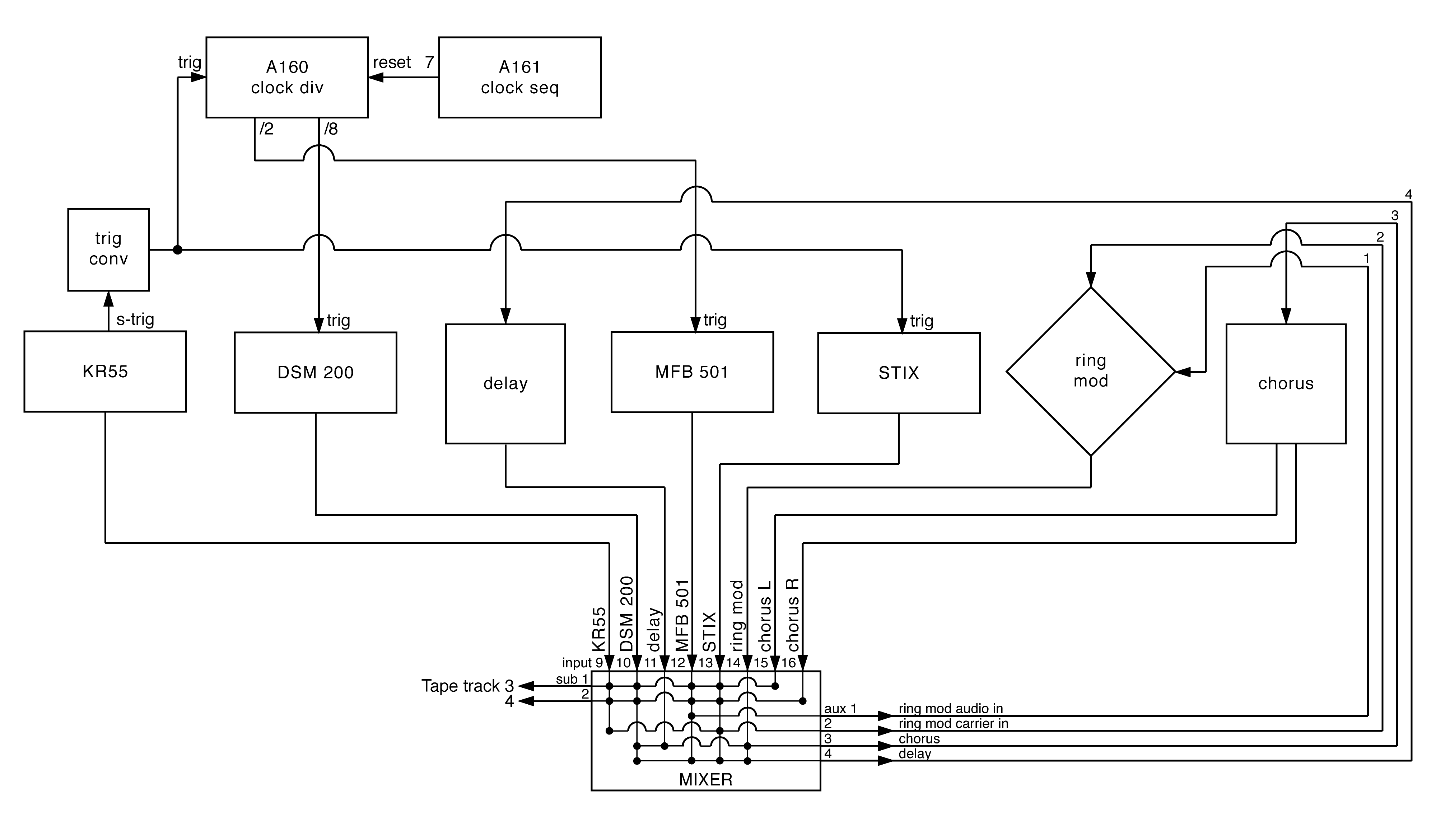Substantive-Hungry Trouser-Word final mix. Unmastered version, digitised directly from tape:
1. Rhythm tracks
In the video you see a false start, then resetting the devices, then recording. The song starts with a fill from the KR-55, then I trigger the MFB 501 on the first beat of the bar. The MFB has a leaky capacitor, and half the time when you press play you get noise (hence the false start). I tap it to get rid of the noise. Once the song is going you see me perform various changes to levels of individual sounds on the KR-55 and the STIX, pressing the fill button on the KR-55 at set points, and muting things in and out on the mixer. You can also hear me sing or count along (so I know where I am in the song). Propped up against the wall is the score:
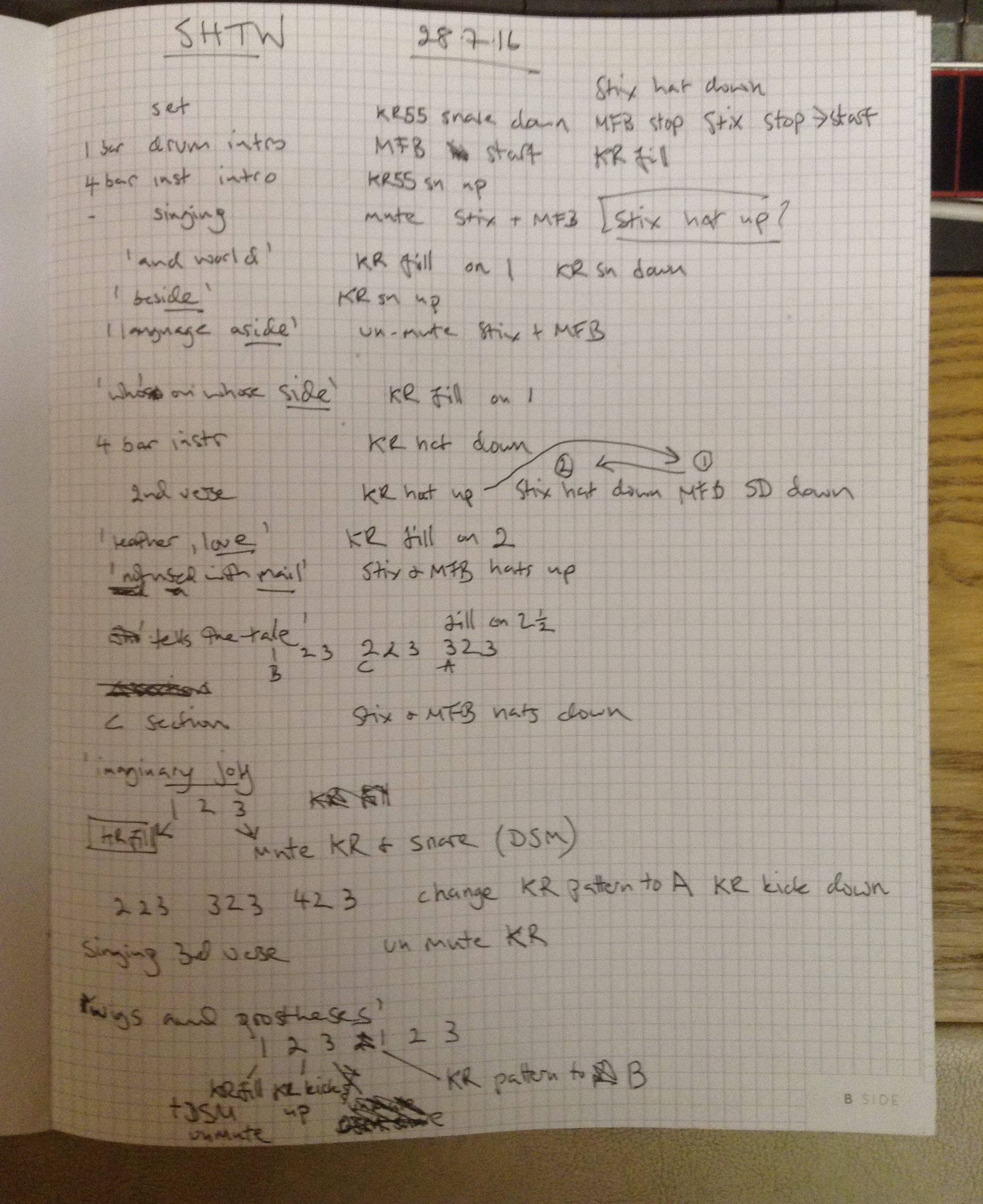
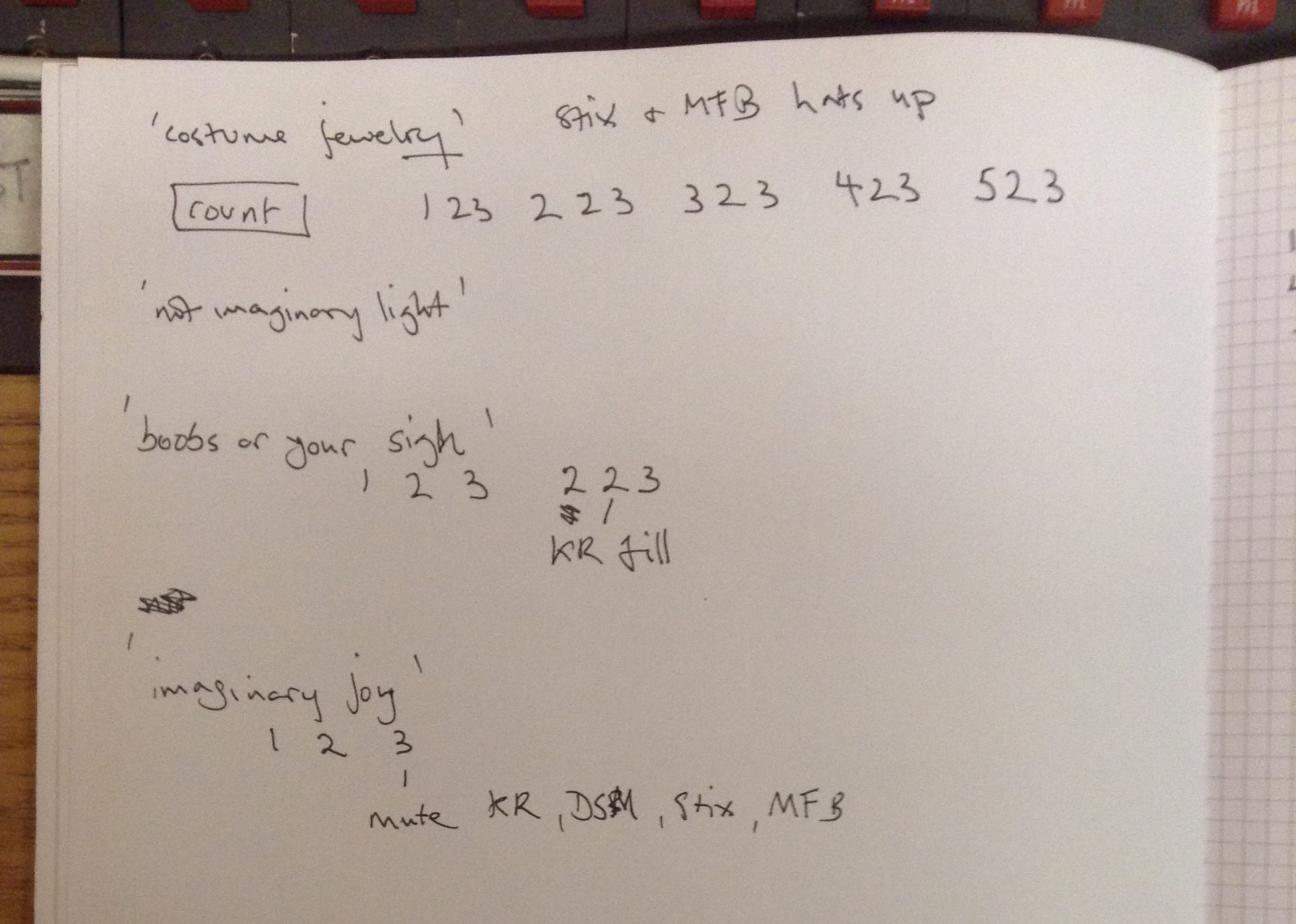
The KR-55 is supplying the masterclock. Since the KR-55 outputs an s-trig (inverted trigger) it has to go through a clock converter to interface with the other drum machines. In this case I’m using the Korg Mono/Poly synth, which accepts s-trig in and can output a standard trigger. The Mono/Poly is not heard. From the Mono/Poly the clock signal is split (via a Doepfer A180 mult) and sent to (1) the STIX trigger in, (2) a Doepfer A160 clock divider, which sends its /2 output to the MFB 501 trigger in, and its /8 to the DSM200 snare. From the mixer various audio signals are sent to ring mod, delay and chorus. A stereo mix of these elements is sent to tape tracks (TT) 3&4.
Schematic of the setup:
Korg KR-55
This preset drum machine supplies the main drum beat and the masterclock, and is panned centrally in the mix. It is set to Ballad 2 for most of the song and changes to Ballad 1 for the 3rd verse. Ballad 1 replaces the snare of Ballad 2 with a rimshot. The rimshot sounds a bit like a tennis ball being struck, which fits with the Wimbledon reference in the lyrics. The mixer EQ gives a small cut at 6k, a small boost at 1k and a big boost at 80Hz.
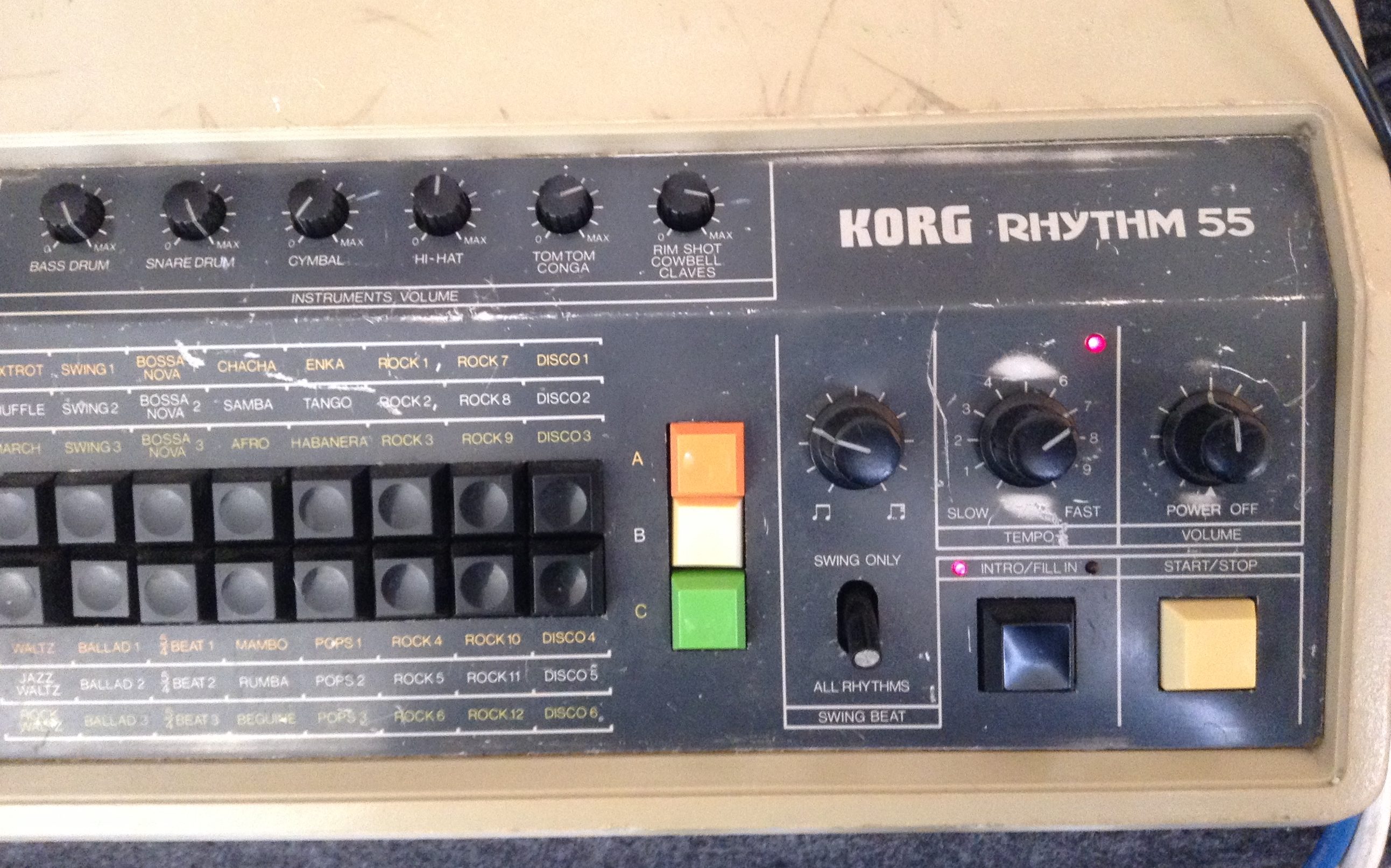
This drum machine is unusual in having degrees of swing. In this case the swing is set just below even triplets, which gives a loping groove that feels right to play along with.
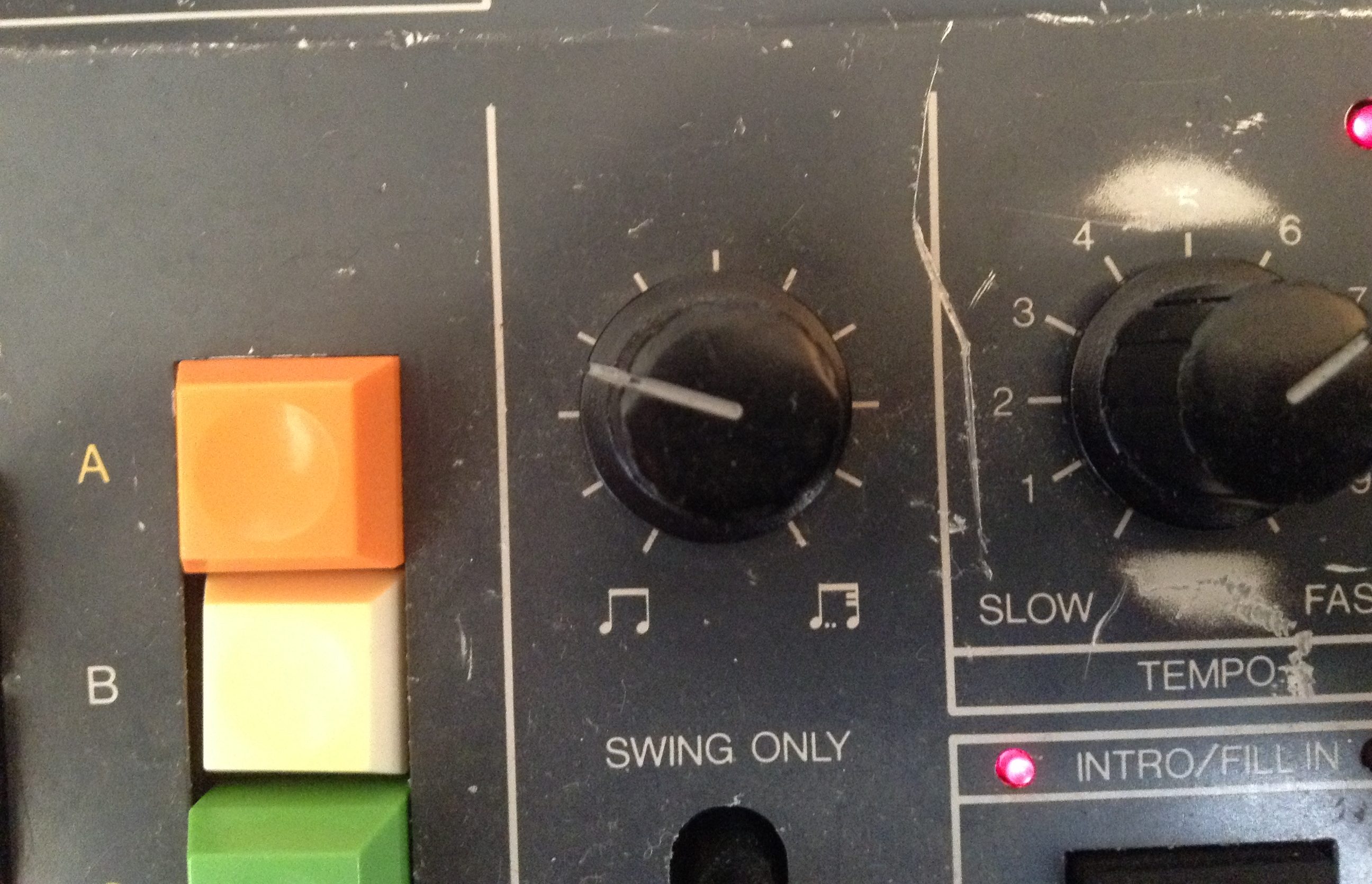
DSM200 snare
This programmable drum synth supplies the main snare sound for the track. It coincides with, and beefs up, the KR-55 snare.

Sound Master STIX ST-305
This programmable drum machine supplies an irregular rhythm that appears in the right hand side of the stereo field from time to time. Its cycle is 16 quavers long, which phases against the 6 (swung) quavers of the main KR-55 rhythm.

MFB 501
This preset drum machine supplies another irregular rhythm that appears in the left hand side of the stereo field from time to time. Its cycle length is 10 quavers, so it phases against the 6 quavers of the main beat and the 16 quavers of the STIX. Due to the leaky capacitor it operates more effectively upside down.

Moog MF-102 ring modulator
The ring mod takes its audio input from the MFB 501 and its carrier input from the KR-55 and the STIX. It only outputs a sound when these two inputs coincide. Its output is not sent to tape, but is heard through the delay and the chorus.
Yamaha E1010 delay
Very short delay with plenty of feedback. applied to DSM200 snare, STIX, MFB 501 and ring mod. Not sent direct to tape, but heard through the chorus.
Boss CE1 chorus
Gives chorus effect and stereo spread to DSM200 snare, delay and ring mod.
At this point the multitrack looks like this:
| TRACK | CONTENTS |
|---|---|
| 1 | |
| 2 | |
| 3 | Rhythm tracks L |
| 4 | Rhythm tracks R |
| 5 | |
| 6 | |
| 7 | |
| 8 |
Guide electric piano and vocal
In order to record the bass and piano it was necessary to have a guide to the track on tape, so I recorded a Hohner Pianet electric piano to TT5 and a scratch vocal to TT8. These would be wiped later, and are not documented, though you hear them in the next couple of videos.
2. Bass
After a false start (and a quick look at camera to check the framing) this take proceeds nicely until the last section, when I make a mistake. You see me wind back the tape to the gap and then drop-in. The majority of the sound here comes from the Moog Freqbox, which tracks the pitch of the bass and outputs a hard-synced synth sound. There is also some of the original bass signal mixed in on the Freqbox, which outputs to a Moog filter. The filter tames the harsh top end of the Freqbox, and also has an envelope follower, which sweeps the cutoff down on each note. You can see the input and envelope LEDs on the filter pulsing away just to the right of the tape machine.
Recording path: Baldwin Baby Bison bass (neck pickup, foam padding next to bridge to damp the sustain) to DBX163 compressor (acting as DI and giving moderate compression) to Moog MF-107 Freqbox to Moog MF-101 filter to mixer (adding a boost at 80Hz) to TT7.
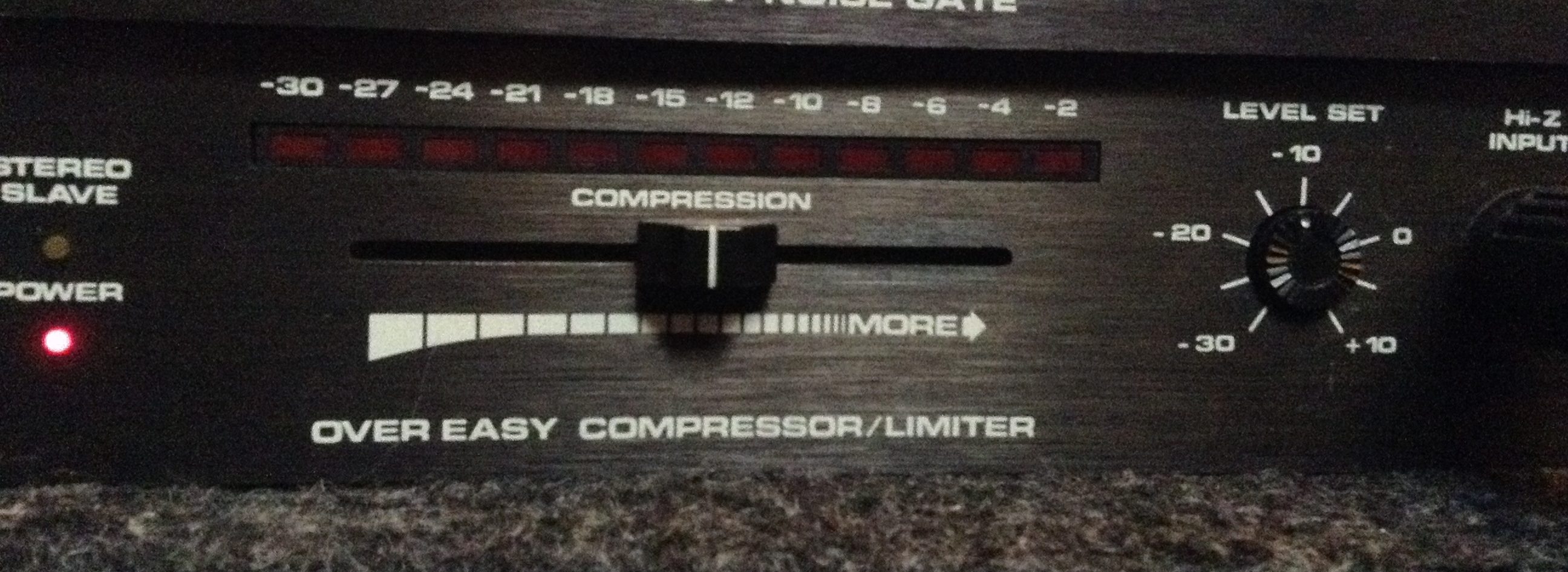
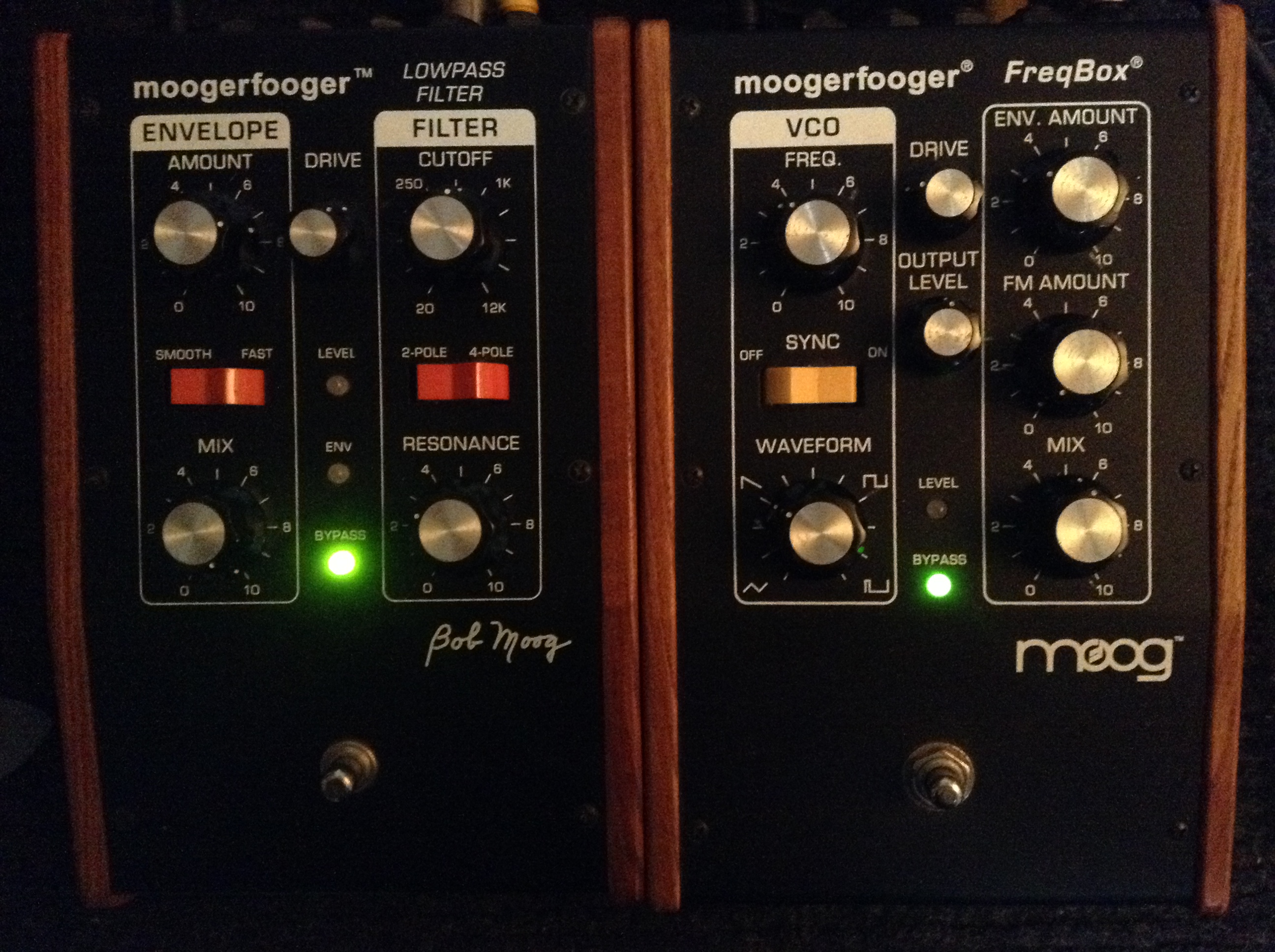
At this stage the multitrack looks like this:
| TRACK | CONTENTS |
|---|---|
| 1 | |
| 2 | |
| 3 | Rhythm tracks L |
| 4 | Rhythm tracks R |
| 5 | Guide pianet |
| 6 | |
| 7 | Bass |
| 8 | Guide vocal |
3. Piano
The piano has to be recorded in one pass (no gaps to drop-in), and is quite difficult to play (big sigh after the take).
Recording path: 2 x AKG414 mics to Eisen preamp to Portico compressor (moderate compression) to PM01 EQ (small boost with wide Q at 8k, small boost with wide Q at 2k, small boost with medium Q at 700k) to TT5&6 (wiping demo pianet).
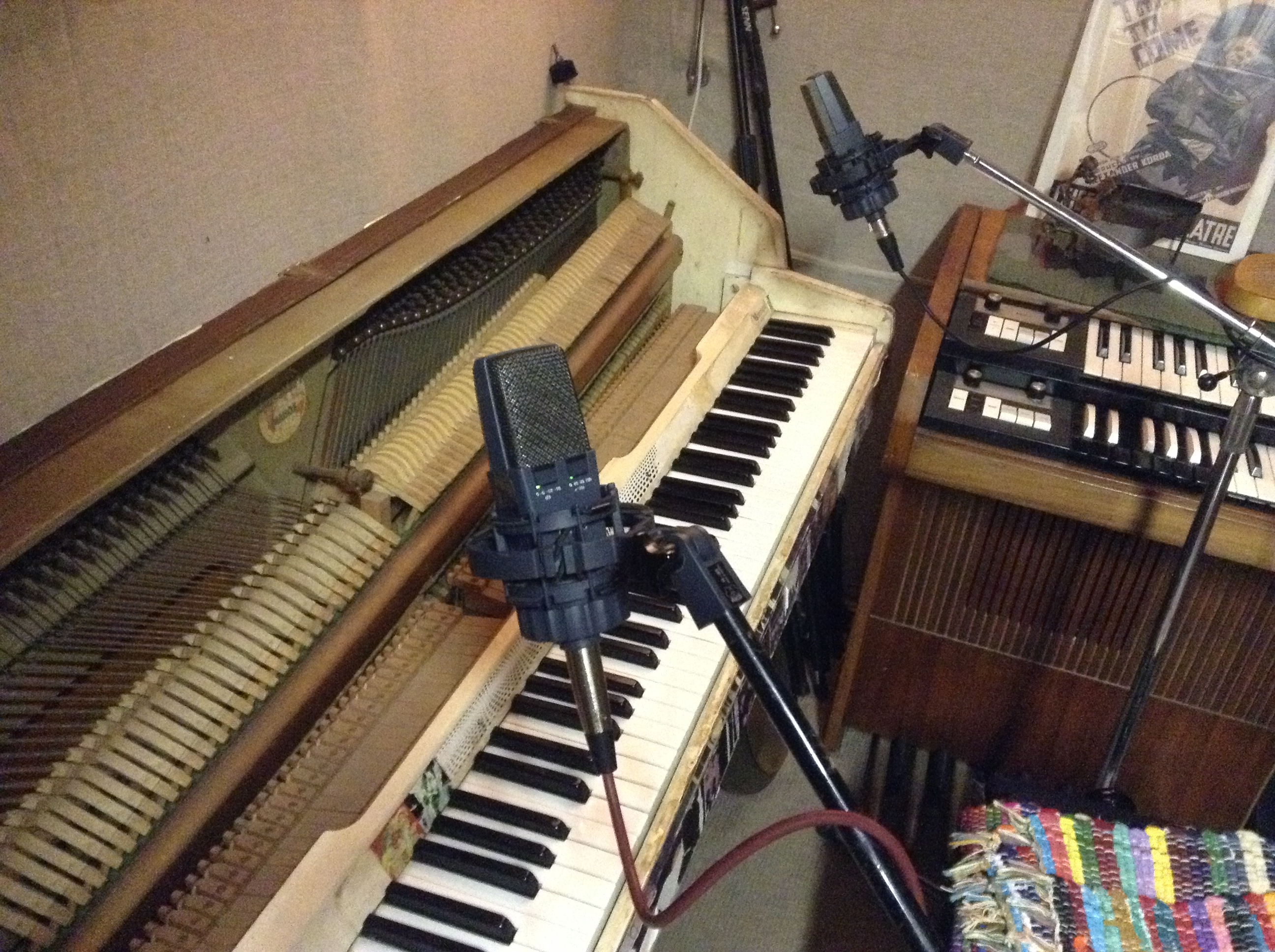
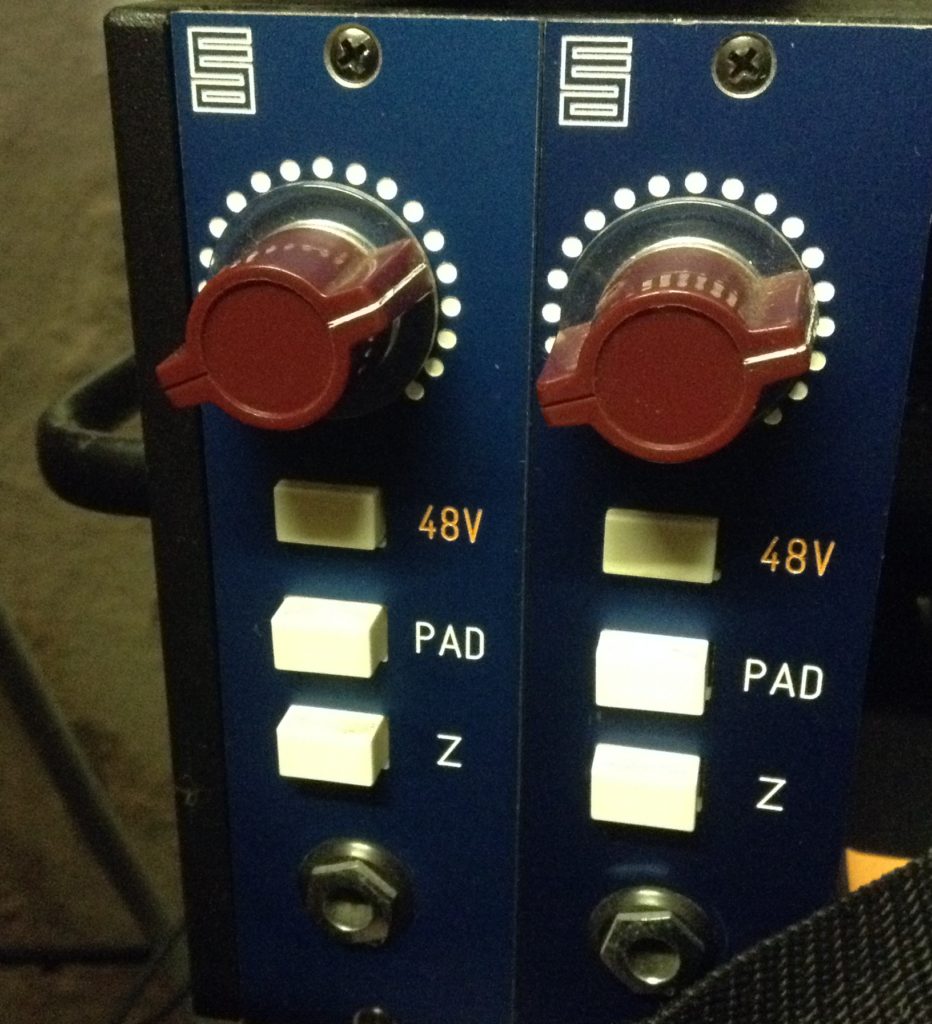
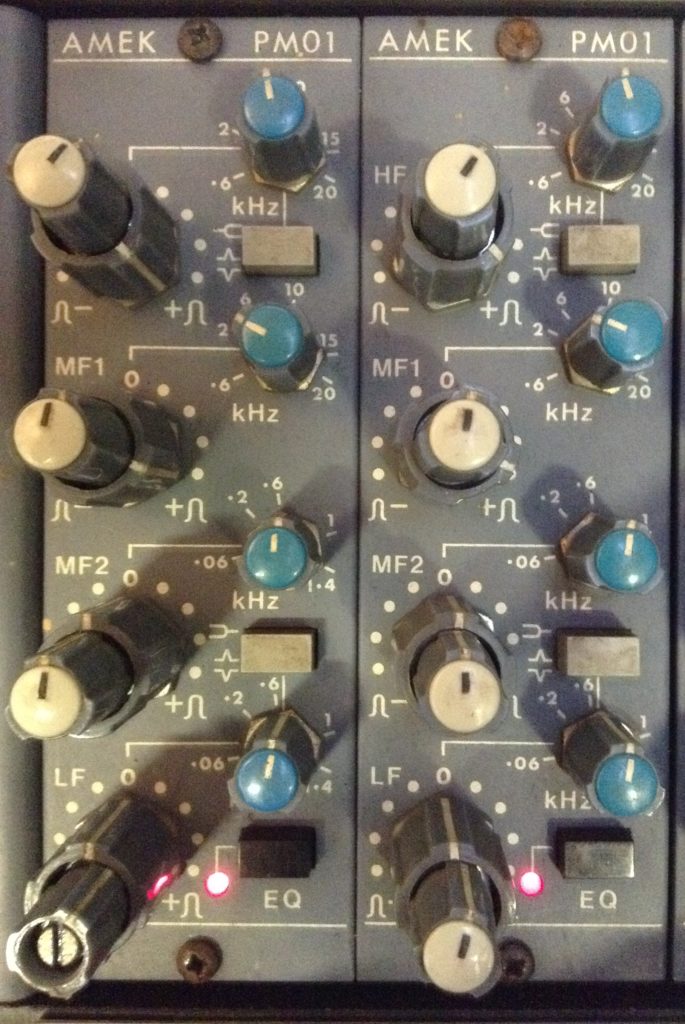
At this stage the multitrack looks like this:
| TRACK | CONTENTS |
|---|---|
| 1 | |
| 2 | |
| 3 | Rhythm tracks L |
| 4 | Rhythm tracks R |
| 5 | Piano L |
| 6 | Piano R |
| 7 | Bass |
| 8 | Guide vocal |
4. Guitar
This double tracked electric guitar part took about three days to set up and record, working on sound and arrangement. I tried various amps, mics, tremelos and boost pedals before hitting on the recording path detailed below. Each of the double tracked guitars had to be played in one go – there were gaps to drop-in, but the piano parts are being simultaneously bounced to the same track as the guitars, and you would hear any drop-ins on the piano. Getting the balance between the guitar and the piano is difficult, and I’ll only know whether this balance works when I get to the mix (by which point it will be impossible to change). Only the first of the two guitar recordings is shown here.
Recording path: Fender Stratocaster to Moog MF-102 ring modulator (used as a tremelo) to a TC Electronics Spark booster pedal (used for the choruses and 3rd verse) to Roland JC77 amp. Sennheiser MD409 mic on amp to Eisen preamp to Portico compressor (heavy compression) to mixer channel 9. From the mixer Biamp spring reverb and Yamaha delay are added, and the guitar, reverb, delay and piano (left for first guitar track, then right for guitar double track) are sent via subgroup 3 to TT2, and then TT8.

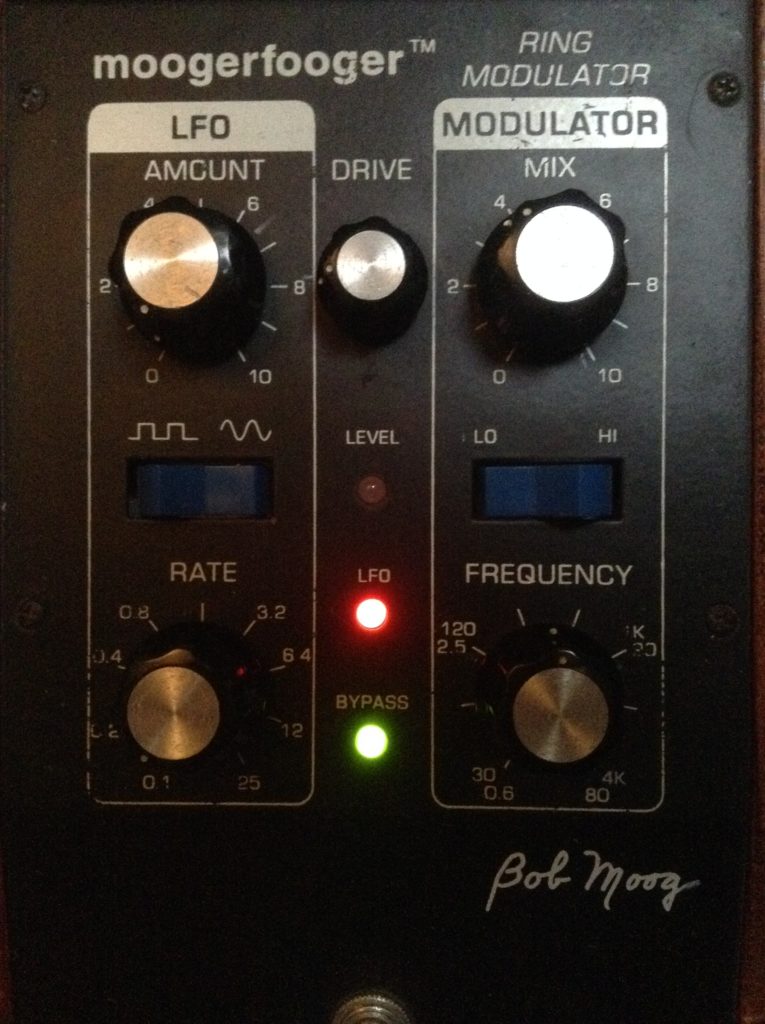
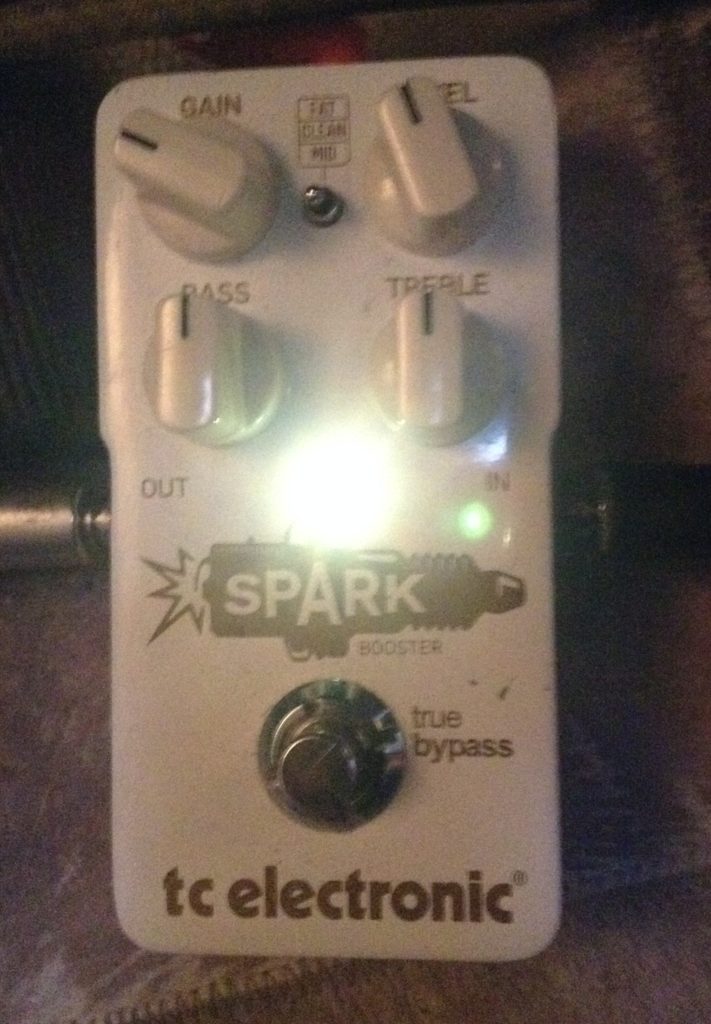
At this stage the multitrack looks like this:
| TRACK | CONTENTS |
|---|---|
| 1 | |
| 2 | Guitar 2 + piano R |
| 3 | Rhythm tracks L |
| 4 | Rhythm tracks R |
| 5 | Piano L [to be recorded over] |
| 6 | Piano R [to be recording over] |
| 7 | Bass |
| 8 | Guitar 1 + piano L |
5. Finger cymbals
Moving these Moroccan finger cymbals into the mic after striking prolongs the sustain; a kind of pre-mix manual automation that anticipates how these types of sound tend to ‘plink’ and then disappear in the mix. I’m not quite sure what happens at 2:18, but I’m obviously not sure about something, so stop the recording, rewind, listen back, decide its ok after all, drop back in and finish the recording.
Recording path: Blue Dragonfly mic to Sytek preamp to Portico compressor (moderate compression) to TT5.
After the finger cymbals are recorded, the reels on the multitrack are reversed, and Biamp spring reverb is applied to the finger cymbals and recorded to TT6. Once the reels are the right way round this sounds as reversed reverb on the finger cymbals.
At this stage the multitrack looks like this:
| TRACK | CONTENTS |
|---|---|
| 1 | |
| 2 | Guitar 2 + piano R |
| 3 | Rhythm tracks L |
| 4 | Rhythm tracks R |
| 5 | Finger cymbals |
| 6 | Finger cymbals reverse reverb |
| 7 | Bass |
| 8 | Guitar 1 + piano L |
With three tracks left to play with (TT1, 5&6) the last stages had to be carefully planned. I knew I wanted double tracked main vocals, panned centrally, and double tracked backing vocals, panned left and right. With the three tracks available this would work best with double tracked main vocals plus finger cymbals on one track and the double tracked backing vocals on the other two tracks. In order to double track the main vocal I would have to do this first, leaving the two remaining tracks for the backing vocals. The backing vocals are not in the whole song, so I could leave the finger cymbals where they were for the first half, and bounce with the main vocal for the second half.
The plan:
- Record 1st half first main vocal to TT1
- Record 2nd half first main vocal and bounce finger cymbals + finger cymbal reversed reverb to TT1
- Double track main vocal while bouncing first main vocal + finger cymbals to TT6 (being careful not to wipe the reverse reverb at the beginning)
- Record BV1 to TT1
- Record BV2 to TT5
6. Double tracked main vocal (with finger cymbals)
The main vocals are recorded in the live room, with the multitrack next to me.
The video shows me double tracking the main vocal to TT6. You can see me drop-in on the vocals near the beginning (left hand on the track arm button while the machine is in record) – this leaves the reverse reverb at the very beginning in place. This is a decent take, but some of the lines were fixed with drop-ins. The first main vocal and drop-ins are not shown here, but follow the standard procedure.
Recording path: Blue Dragonfly mic to Eisen preamp to Portico compressor (medium compression) to mixer channel 10 (adding a small amount of EQ at 6k) to: (1) direct to TT1 for 1st half first main vocal, (2) mixed with finger cymbals (TT5&6) to TT1 for 2nd half of first main vocal, (3) mixed with TT1 for double track main vocal.
At this stage the multitrack looks like this:
| TRACK | CONTENTS |
|---|---|
| 1 | Main vocal + finger cymbals [to be recorded over] |
| 2 | Guitar 2 + piano R |
| 3 | Rhythm tracks L |
| 4 | Rhythm tracks R |
| 5 | Finger cymbals |
| 6 | Main vocal double track + finger cymbals |
| 7 | Bass |
| 8 | Guitar 1 + piano L |
7. Backing vocals
I was delighted when Laetitia Sadier offered to sing backing vocals for me. I’ve known and worked with her for many years and she’s fantastic in the studio.
My studio was not behaving itself very well for this session, and I realised how used I am to working around the various niggles and intermittent problems it manifests. This session put that into sharp focus.
Most of the backing vocals involve a single double tracked line, which Laetitia sang in the live room, while I engineered and gave directions in the control room. For the end section (shown in the video) I needed a high and a low BV, also double tracked, so I sang at the same time as Laetitia (while engineering, and giving directions). This was one of the most challenging processes of the whole recording of the EP.
Recording path:
Laetitia: Blue Dragonful mic to undocumented preamp to Portico compressor (light compression) to mixer ch9 to subgroup 3 to TT1 (first BVs) then TT5 (double track)
Joe: Sennheiser MD408 to undocumented preamp to Portico compressor (light compression) to mixer ch 10 to subgroup 3 to TT1 (first BVs) then TT5 (double track)
At this stage the multitrack is full and looks like this:
| TRACK | CONTENTS |
|---|---|
| 1 | BVs L |
| 2 | Guitar 2 + piano R |
| 3 | Rhythm tracks L |
| 4 | Rhythm tracks R |
| 5 | BVs R + finger cymbals |
| 6 | Main vocal double track + finger cymbals |
| 7 | Bass |
| 8 | Guitar 1 + piano L |
Final mix
The performance of this mix follows a score and is rehearsed. In the video you can see various mutes (mostly to backing vocals) and fader rides. At 1:22 (and again at 2:04) I bring in the ring mod effect on the vocal. I also have to get the finger cymbals in at the right volume at various points from their various locations.
The following table details the routing and settings of the Amek BCII mixer. Note, all pot settings for EQs and auxes given as clock face readings (o’clock): e.g. 11:30 indicates the pot is just to the left of pointing straight up. This would be a small cut in an EQ (12:00 being off) and medium gain for an aux.
| Ch | Sound | Routing | Pan | Main mix | Sub 1 (ring mod audio in) | Sub 2 (Freqbox audio in) | Aux 1 (GB spring) | Aux 2 (Biamp spring) | Aux 3 (delay) | Aux 4 (chorus) | Mixer EQ | Low cut |
|---|---|---|---|---|---|---|---|---|---|---|---|---|
| 1 | BVs L | TT1 to PM01 EQ to BC316 comp to ch1 | L | In | 12:00 | 12:00 | 9:00 | In | ||||
| 2 | Piano + guitar R | Direct | R | In | 6k 1:00 80Hz 1:00 | |||||||
| 3 | Rhythm tracks L | Direct | L | In | 6k 1:00 80Hz 1:00 | |||||||
| 4 | rhythm tracks R | Direct | R | In | 6k 1:00 80Hz 1:00 | |||||||
| 5 | BVs R + finger cymbals | TT5 to PM01 EQ to BC316 comp to ch5 | R | In | 12:00 | 12:00 | 11:00 | 6k 1:30 400Hz 1:30 | ||||
| 6 | Main vocal + finger cymbals | TT6 to PM01 EQ to Portico comp to ch6 | C | In | In | In | 11:00 | 12:30 | 12:30 | |||
| 7 | Bass | Direct | C | In | 80Hz 1:00 | |||||||
| 8 | Piano + guitar L | Direct | L | In | 6k 1:00 80Hz 1:00 | |||||||
| 9 | GB spring | Direct | R | In | 6k 1:30 | In | ||||||
| 10 | Biamp spring | Biamp spring out to out to Drawmer comp/gate to ch10 | n/a | Out (heard through Boss chorus) | 10:30 | 11:00 | In | |||||
| 11 | Ring mod/Freqbox | Ring mod out to ch11 | C | In (out on verses) | 11:30 | 9:00 | ||||||
| 12 | Yamaha delay | Direct | L | In | 10:30 | 9:30 | ||||||
| 13 | Boss chorus L | Direct | L | In | 12k 12:30 3k 12:30 | In | ||||||
| 14 | Boss chorus R | Direct | R | In | 12k 12:30 3k 12:30 | In |
Routing
Aux 1: to PM01 EQ to GB spring
Aux2: to Biamp spring
Aux3: to Yamaha E1010 delay
Aux4: to Boss CE01 chorus
Subgroup 1 (main vocal): to Moog MF-102 ring modulator audio in
Subgroup 2 (main vocal): to Moog MF-107 Freqbox audio in
Freqbox audio out to ring mod carrier in (ring mod out to ch11)
Subgroup 2 sends the main vocal to the Freqbox, which tracks the pitch and outputs a hard-synced synth sound to the carrier in of the ring mod, where it is ring modulated with the original vocal. This gives a distorted effect that can be heard in the choruses.
Subgroup 3 & 4 are used for parallel compression applied to a mix of the rhythm tracks L&R and the piano + guitar L&R. Mixer channels 2, 3, 4 & 8 are sent to subgroups 3 & 4, which send via inserts to a DBX 163/463 stereo compressor, set to very heavy compression. The compressed signal is sent to the main mix.
The following table gives settings for the Amek PM01 outboard EQ:
| Applied to | Band 1 high | Band 2 hi-mid | Band 3 lo-mid | Band 4 low | ||||||||
|---|---|---|---|---|---|---|---|---|---|---|---|---|
| Freq | Gain | Q | Freq | Gain | Q | Freq | Gain | Q | Freq | Gain | Q | |
| TT1 & 5 BVs L & R | 9k | 3:30 | narrow (shelf) | 7k | 11:00 | medium | 800Hz | 2:00 | wide | 800Hz | 1:30 | medium |
| TT6 main vocal | 7k | 2:00 | wide (shelf) | 700Hz | 2:30 | wide | ||||||
| Aux 2 send to Biamp spring | 7k | 1:30 | wide | 2k | 9:30 | narrow | 600Hz | 9:30 | narrow | 1k | 11:30 | wide |

You can hear a digitised version of this mix at the TOP of this page.
